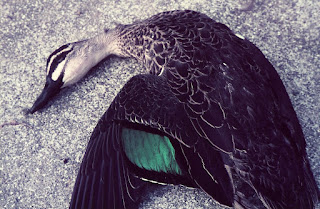 |
| Male Shovellor |
The diverse aquatic habitats in Southland suit so many of New Zealand’s waterfowl that it’s easiest to start off with what’s not there. The Mute swan, the big white one, has never survived long out of captivity in Southland. Individuals show up from time to time but the bird doesn’t compete with the Black swan. The Brown teal, formerly abundant everywhere has disappeared from the South Island and Stewart Island, shot to near extinction, taken by mustelids and hybridised with other ducks. The Flightless goose and several species of flightless ducks did not survive Maori hunting nor the depredations of the kiore or Polynesian rat which swept through the country like a dose of salts about 700 years ago.
The other waterfowl are doing well with a couple of exceptions. A few Blue ducks or whio live in swiftly flowing rivers feeding Lake Te Anau and west of the divide and they have been reported from Redcliffs and a few other places. The Grey duck is in decline as its population cross-breeds with mallards. Genuine Grey ducks are scarce and largely confined to remoter, higher altitude lakes and valleys. They are quite distinctive with their strong eye stripe and green flash on the wing.
 |
| Dead mystery duck |
Mallards are the commonest waterfowl in New Zealand. They breed rapidly and prolifically, tolerate water of any quality and rapidly colonise urban and agricultural ponds, quieter stretches of river and roadside ditches. Paradise ducks were nearly shot out but after a few years of protection the numbers sky-rocketed and they are now everywhere on lakes and farm ponds or in rough grassland near tarns.
The Grey teal and the shovellor are lake species and the Black teal or scaup is a common sight on the larger lakes, often forming flocks of several hundreds. It is our only diving duck and the bird single-handedly responsible for ruining the mirror effect of the Mirror Lakes on the Milford Road. Black swans thrive on wetlands, building bulky nests. Small gaggles of white or grey feral geese live on scrubby grazing land.
 |
| Grey Duck |
The Canada goose has recently lost its gamebird status and can now be hunted freely. It remains to be seen whether or not we will end up with more of them or fewer. Without Fish and Game input into management it is likely that numbers will grow on conservation land and farmers, who are adversely affected by grazing geese, may struggle to keep numbers down. Oddities turn up as well – occasional Chestnut-breasted shelducks, Cape Barren geese and Wood ducks from Australia. I have a picture of a duck that looks about halfway between a mallard and a Paradise duck. Have a look and tell me what you think.